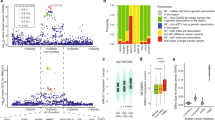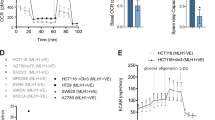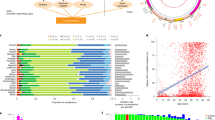Abstract
Mitochondrial dysfunction has been a hallmark of cancer. However, whether it has a causative role awaits to be elucidated. Here, using an animal model derived from inactivation of SUV3, a mitochondrial helicase, we demonstrated that mSuv3+/− mice harbored increased mitochondrial DNA (mtDNA) mutations and decreased mtDNA copy numbers, leading to tumor development in various sites and shortened lifespan. These phenotypes were transmitted maternally, indicating the etiological role of the mitochondria. Importantly, reduced SUV3 expression was observed in human breast tumor specimens compared with corresponding normal tissues in two independent cohorts. These results demonstrated for the first time that maintaining mtDNA integrity by SUV3 helicase is critical for cancer suppression.
This is a preview of subscription content, access via your institution
Access options
Subscribe to this journal
Receive 50 print issues and online access
$259.00 per year
only $5.18 per issue
Buy this article
- Purchase on Springer Link
- Instant access to full article PDF
Prices may be subject to local taxes which are calculated during checkout







Similar content being viewed by others
References
Harman D . The biologic clock: the mitochondria? J Am Geriatr Soc 1972; 20: 145–147.
Wallace DC, Fan W . The pathophysiology of mitochondrial disease as modeled in the mouse. Genes Dev 2009; 23: 1714–1736.
Attardi G, Schatz G . Biogenesis of mitochondria. Annu Rev Cell Biol 1988; 4: 289–333.
Golden TR, Melov S . Mitochondrial DNA mutations, oxidative stress, and aging. Mech Ageing Dev 2001; 122: 1577–1589.
de Grey AD . The reductive hotspot hypothesis of mammalian aging: membrane metabolism magnifies mutant mitochondrial mischief. Eur J Biochem 2002; 269: 2003–2009.
Yui R, Ohno Y, Matsuura ET . Accumulation of deleted mitochondrial DNA in aging Drosophila melanogaster. Genes Genet Syst 2003; 78: 245–251.
Warburg O, Wind F, Negelein E . The metabolism of tumors in the body. J Gen Physiol 1927; 8: 519–530.
Chatterjee A, Mambo E, Sidransky D . Mitochondrial DNA mutations in human cancer. Oncogene 2006; 25: 4663–4674.
Golik P, Szczepanek T, Bartnik E, Stepien PP, Lazowska J . The S. cerevisiae nuclear gene SUV3 encoding a putative RNA helicase is necessary for the stability of mitochondrial transcripts containing multiple introns. Curr Genet 1995; 28: 217–224.
Margossian SP, Li H, Zassenhaus HP, Butow RA . The DExH box protein Suv3p is a component of a yeast mitochondrial 3′-to-5′ exoribonuclease that suppresses group I intron toxicity. Cell 1996; 84: 199–209.
Dziembowski A, Piwowarski J, Hoser R, Minczuk M, Dmochowska A, Siep M et al. The yeast mitochondrial degradosome. Its composition, interplay between RNA helicase and RNase activities and the role in mitochondrial RNA metabolism. J Biol Chem 2003; 278: 1603–1611.
Stepien PP, Margossian SP, Landsman D, Butow RA . The yeast nuclear gene suv3 affecting mitochondrial post-transcriptional processes encodes a putative ATP-dependent RNA helicase. Proc Natl Acad Sci USA 1992; 89: 6813–6817.
Stepien PP, Kokot L, Leski T, Bartnik E . The suv3 nuclear gene product is required for the in vivo processing of the yeast mitochondrial 21s rRNA transcripts containing the r1 intron. Curr Genet 1995; 27: 234–238.
Khidr L, Wu G, Davila A, Procaccio V, Wallace D, Lee WH . Role of SUV3 helicase in maintaining mitochondrial homeostasis in human cells. J Biol Chem 2008; 283: 27064–27073.
Pereira M, Mason P, Szczesny RJ, Maddukuri L, Dziwura S, Jedrzejczak R et al. Interaction of human SUV3 RNA/DNA helicase with BLM helicase; loss of the SUV3 gene results in mouse embryonic lethality. Mech Ageing Dev 2007; 128: 609–617.
Todaro GJ, Green H . Quantitative studies of the growth of mouse embryo cells in culture and their development into established lines. J Cell Biol 1963; 17: 299–313.
Zheng L, Lee WH . Retinoblastoma tumor suppressor and genome stability. Adv Cancer Res 2002; 85: 13–50.
Chen PL, Chen Y, Bookstein R, Lee WH . Genetic mechanisms of tumor suppression by the human p53 gene. Science 1990; 250: 1576–1580.
Ting NS, Lee WH . The DNA double-strand break response pathway: becoming more BRCAish than ever. DNA Repair 2004; 3: 935–944.
Riley DJ, Lee EY, Lee WH . The retinoblastoma protein: more than a tumor suppressor. Annu Rev Cell Biol 1994; 10: 1–29.
Rowley PT . Inherited susceptibility to colorectal cancer. Annu Rev Med 2005; 56: 539–554.
Hickson ID . RecQ helicases: caretakers of the genome. Nat Rev Cancer 2003; 3: 169–178.
Markowitz SD, Wang JY, Myeroff L, Parsons R, Sun L, Lutterbaugh J et al. Inactivation of the type II TGF-beta receptor in colon cancer cells with microsatellite instability. Science 1995; 268: 1336–1338.
Okuda T, van Deursen J, Hiebert SW, Grosveld G, Downing JR . AML1, the target of multiple chromosomal translocations in human leukemia, is essential for normal fetal liver hematopoiesis. Cell 1996; 84: 321–330.
Fero ML, Randel E, Gurley KE, Roberts JM, Kemp CJ . The murine gene p27Kip1 is haplo-insufficient for tumour suppression. Nature 1998; 396: 177–180.
Bardeesy N, Sinha M, Hezel AF, Signoretti S, Hathaway NA, Sharpless NE et al. Loss of the Lkb1 tumour suppressor provokes intestinal polyposis but resistance to transformation. Nature 2002; 419: 162–167.
Chen PL, Liu F, Cai S, Lin X, Li A, Chen Y et al. Inactivation of CtIP leads to early embryonic lethality mediated by G1 restraint and to tumorigenesis by haploid insufficiency. Mol Cell Biol 2005; 25: 3535–3542.
Alberici P, Jagmohan-Changur S, De Pater E, Van Der Valk M, Smits R, Hohenstein P et al. Smad4 haploinsufficiency in mouse models for intestinal cancer. Oncogene 2006; 25: 1841–1851.
Lin X, Liu CC, Gao Q, Zhang X, Wu G, Lee WH . RINT-1 serves as a tumor suppressor and maintains Golgi dynamics and centrosome integrity for cell survival. Mol Cell Biol 2007; 27: 4905–4916.
Guo XE, Chen CF, Wang DD, Modrek AS, Phan VH, Lee WH et al. Uncoupling the roles of the SUV3 helicase in maintenance of mitochondrial genome stability and RNA degradation. J Biol Chem 2011; 286: 38783–38794.
Wang DD, Shu Z, Lieser SA, Chen PL, Lee WH . Human mitochondrial SUV3 and polynucleotide phosphorylase form a 330-kDa heteropentamer to cooperatively degrade double-stranded RNA with a 3′-to-5′ directionality. J Biol Chem 2009; 284: 20812–20821.
Shu Z, Vijayakumar S, Chen CF, Chen PL, Lee WH . Purified human SUV3p exhibits multiple-substrate unwinding activity upon conformational change. Biochemistry 2004; 43: 4781–4790.
Bogenhagen DF, Rousseau D, Burke S . The layered structure of human mitochondrial DNA nucleoids. J Biol Chem 2008; 283: 3665–3675.
Trifunovic A, Wredenberg A, Falkenberg M, Spelbrink JN, Rovio AT, Bruder CE et al. Premature ageing in mice expressing defective mitochondrial DNA polymerase. Nature 2004; 429: 417–423.
Kujoth GC, Hiona A, Pugh TD, Someya S, Panzer K, Wohlgemuth SE et al. Mitochondrial DNA mutations, oxidative stress, and apoptosis in mammalian aging. Science 2005; 309: 481–484.
Vermulst M, Bielas JH, Kujoth GC, Ladiges WC, Rabinovitch PS, Prolla TA et al. Mitochondrial point mutations do not limit the natural lifespan of mice. Nature Genet 2007; 39: 540–543.
Trifunovic A, Hansson A, Wredenberg A, Rovio AT, Dufour E, Khvorostov I et al. Somatic mtDNA mutations cause aging phenotypes without affecting reactive oxygen species production. Proc Natl Acad Sci USA 2005; 102: 17993–17998.
Zanssen S, Schon EA . Mitochondrial DNA Mutations in Cancer. PLoS Med 2005; 2: e401.
Polyak K, Li Y, Zhu H, Lengauer C, Willson JK, Markowitz SD et al. Somatic mutations of the mitochondrial genome in human colorectal tumours. Nature Genet 1998; 20: 291–293.
He Y, Wu J, Dressman DC, Iacobuzio-Donahue C, Markowitz SD, Velculescu VE et al. Heteroplasmic mitochondrial DNA mutations in normal and tumour cells. Nature 2010; 464: 610–614.
Burdon RH . Superoxide and hydrogen peroxide in relation to mammalian cell proliferation. Free Rad Biol Med 1995; 18: 775–794.
Wallace DC, Fan W, Procaccio V . Mitochondrial energetics and therapeutics. Annu Rev Pathol 2010; 5: 297–348.
Kim HS, Patel K, Muldoon-Jacobs K, Bisht KS, Aykin-Burns N, Pennington JD et al. SIRT3 is a mitochondria-localized tumor suppressor required for maintenance of mitochondrial integrity and metabolism during stress. Cancer Cell 2010; 17: 41–52.
Yan H, Parsons DW, Jin G, McLendon R, Rasheed BA, Yuan W et al. IDH1 and IDH2 mutations in gliomas. N Engl J Med 2009; 360: 765–773.
Xu W, Yang H, Liu Y, Yang Y, Wang P, Kim SH et al. Oncometabolite 2-hydroxyglutarate is a competitive inhibitor of Éø-ketoglutarate-dependent dioxygenases. Cancer Cell 2011; 18: 17–30.
Soriano P, Montgomery C, Geske R, Bradley A . Targeted disruption of the c-src proto-oncogene leads to osteopetrosis in mice. Cell 1991; 64: 693–702.
Lee EY-HP, Chang C-Y, Hu N, Wang Y-CJ, Lai C-C, Herrup K et al. Mice deficient for Rb are nonviable and show defects in neurogenesis and haematopoiesis. Nature 1992; 359: 288–294.
Liu CY, Flesken-Nikitin A, Li S, Zeng Y, Lee W-H . Inactivation of the mouse Brca1 gene leads to failure in the morphogenesis of the egg cylinder in early postimplantation development. Genes Dev 1996; 10: 1835–1843.
Rodríguez-Santiago B, Casademont J, Nunes V . Is mitochondrial DNA depletion involved in Alzheimer's disease? Eur J Hum Genet 2001; 9: 279–285.
Coskun PE, Beal MF, Wallace DC . Alzheimer's brains harbor somatic mtDNA control-region mutations that suppress mitochondrial transcription and replication. Proc Natl Acad Sci USA 2004; 101: 10726–10731.
Trounce IA, Kim YL, Jun AS, Wallace DC . Assessment of mitochondrial oxidative phosphorylation in patient muscle biopsies, lymphoblasts, and transmitochondrial cell lines. Methods Enzymol 1996; 264: 484–509.
Acknowledgements
We thank Dennis Wang for his critical reading, Dr Tom Doetschman for providing 129/Sv mouse genomic library, Andrea Nikitin, Suna Cai and Weiwei Fan for their excellent assistance. This study was supported by grant NIH AG027877 to WHL and PLC, and NS21328 and AG13154 to DCW. Based on the UCI's policy, it is declared that WHL serves as a member of Board of Directors of GeneTex, Inc. This arrangement has been reviewed and approved by the UCI COI committee.
Author Contributions: PLC and WHL conceptualized experiments, prepared figures and drafted the manuscript. CFC performed majority of the experiments. YC performed the time pregnancy analysis. XEG performed cell experiments. JYS and CKH analyzed the SUV3 expression level in human tumor specimens and RLR analyzed histology experiments. DCW provided scientific advice and critical comments on manuscript.
Author information
Authors and Affiliations
Corresponding authors
Ethics declarations
Competing interests
The authors declare no conflict of interest.
Rights and permissions
About this article
Cite this article
Chen, PL., Chen, CF., Chen, Y. et al. Mitochondrial genome instability resulting from SUV3 haploinsufficiency leads to tumorigenesis and shortened lifespan. Oncogene 32, 1193–1201 (2013). https://doi.org/10.1038/onc.2012.120
Received:
Revised:
Accepted:
Published:
Issue Date:
DOI: https://doi.org/10.1038/onc.2012.120
Keywords
This article is cited by
-
Association between oxidative stress, mitochondrial function of peripheral blood mononuclear cells and gastrointestinal cancers
Journal of Translational Medicine (2023)
-
Spotlight on the relevance of mtDNA in cancer
Clinical and Translational Oncology (2017)
-
Mitochondrial DNA repair: a novel therapeutic target for heart failure
Heart Failure Reviews (2016)
-
Impaired Mitochondrial Metabolism and Mammary Carcinogenesis
Journal of Mammary Gland Biology and Neoplasia (2013)



